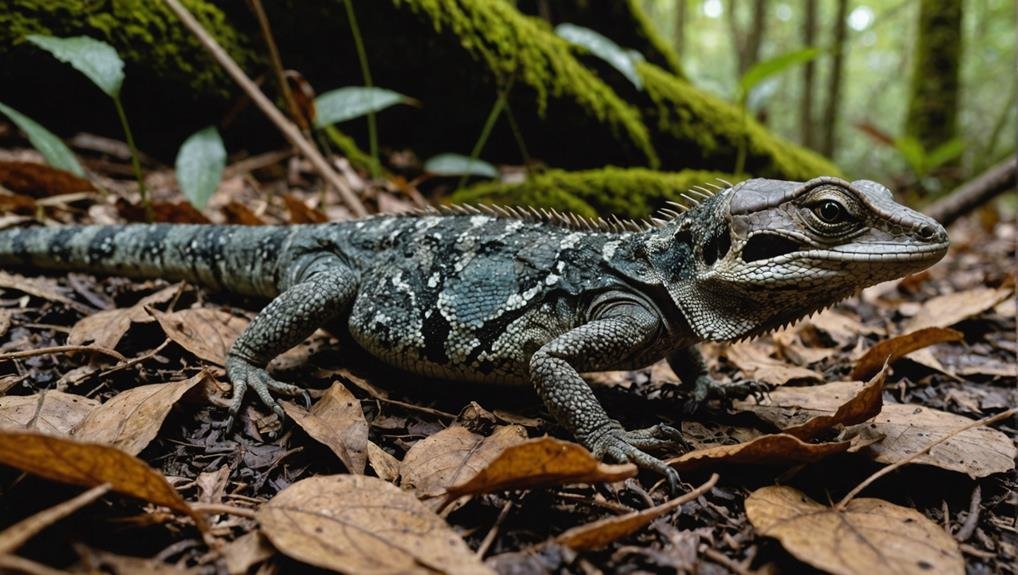You might wonder if a dead lizard in your Home can attract pests, and the answer is yes. When a lizard dies, it releases odors during decomposition that can draw flies, ants, cockroaches, and beetles. These pests are not only a nuisance but can also pose health risks. Understanding why dead lizards attract pests and how to manage the situation is vital for maintaining a clean environment. So, what steps should you take to prevent these unwanted visitors and guarantee your Home remains pest-free?
Key Takeaways
- Dead lizards release odors that attract pests like flies, ants, and cockroaches.
- Decomposing lizards creates unsanitary conditions that lead to secondary pest infestations.
- Scavenging insects like beetles are drawn to decomposing lizards for feeding and breeding.
- Decomposing lizards can trigger allergic reactions and spread diseases through attracted pests.
- Immediate disposal of dead lizards is crucial to prevent pest attraction and health hazards.
Why Dead Lizards Attract Pests
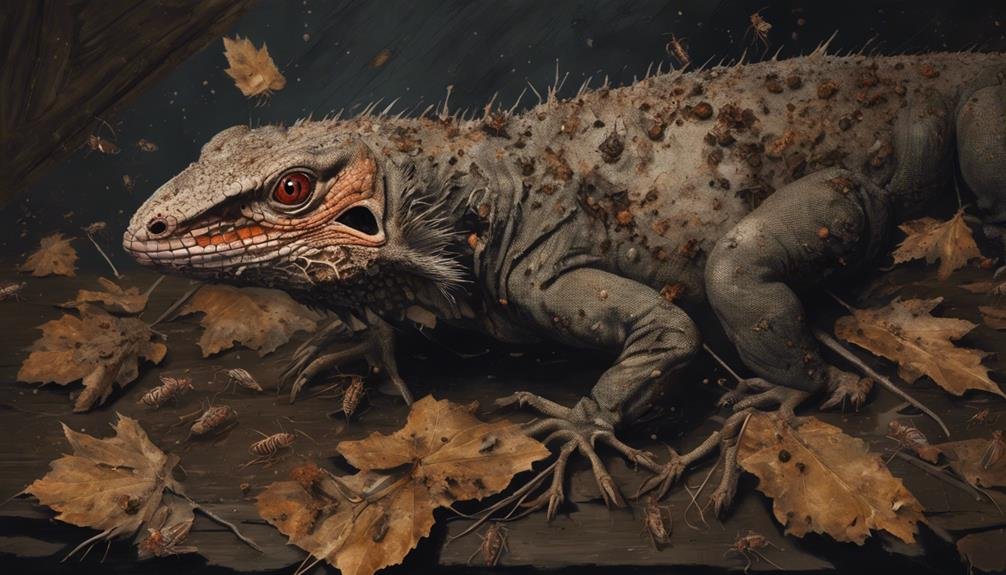

Due to their decomposition process, dead lizards can quickly become magnets for pests. When a lizard dies, its body begins to break down, releasing odors that attract pests like flies and ants. These pests are drawn to the smell as they search for food sources, making dead lizards particularly enticing.
You mightn’t realize it, but those decomposing odors can lead to secondary pest infestations in your Home. Flies, ants, and other scavengers will flock to the dead lizards, and once they’re inside, they may start exploring different parts of your Home. This can turn a simple issue into a bigger pest problem, affecting your comfort and hygiene.
Proper disposal of dead lizards is essential to prevent attracting pests indoors. If you find a dead lizard in your Home, it’s important to remove it promptly. Doing so reduces the risk of attracting pests and the potential for secondary infestations.
Ensuring that dead lizards are disposed of properly helps maintain a pest-free environment in your Home, saving you from dealing with unwanted insects and other pests.
Types of Pests Attracted
When a lizard decomposes, it can attract pesky insects into your Home. Thanks to the decaying matter they provide, dead lizards offer a feast for many pests.
- Flies: These insects are usually the first to arrive. They’re drawn to the scent of decay and will quickly lay their eggs on the carcass. Once hatched, the larvae, or maggots, feed on the dead lizard, accelerating the decomposition process.
- Ants: Attracted by the scent of decaying matter, ants swarm the area, scavenging the carcass for food. They can create a trail that leads other pests into your Home.
- Cockroaches: Known for their preference for dark, damp places, cockroaches are also drawn to dead lizards. The decomposing lizard provides them with a food source and a breeding ground.
- Beetles: Various beetle species are attracted to dead lizards. They feed on the decomposing tissues and can lay eggs, leading to an increased beetle population in your Home.
Proper removal of dead lizards is essential to prevent attracting these pests, leading to further infestations and hygiene issues in your living space.
The Decomposition Process
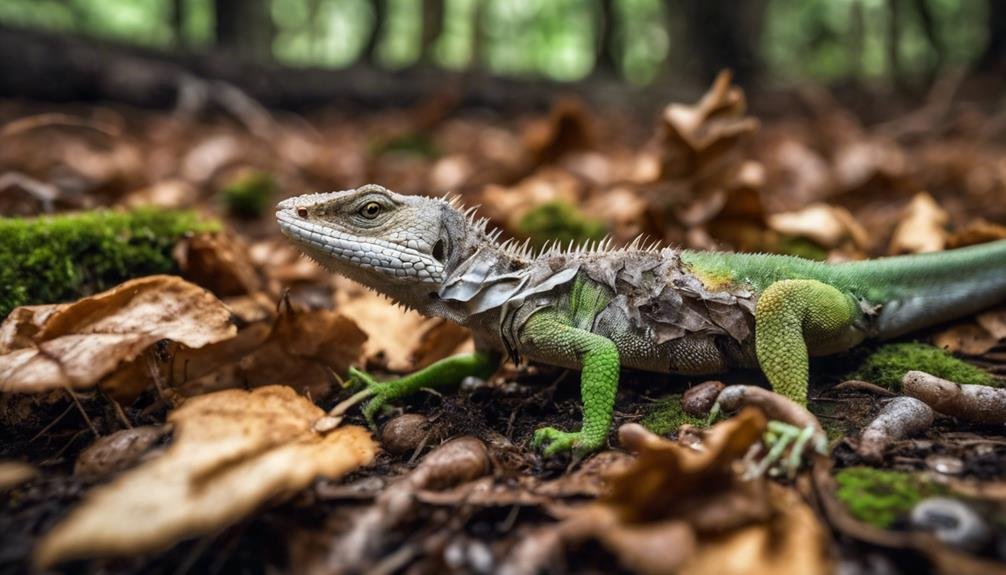

When a lizard dies, its body undergoes stages of decomposition that release strong odors, attracting pests like flies, beetles, and ants. These pests create unsanitary conditions and pose health hazards by spreading bacteria and other pathogens. To avoid these issues, it is essential to remove and dispose of dead lizards promptly.
Stages of Decomposition
The decomposition process of lizards involves several distinct stages, each marked by specific changes and challenges. As a lizard’s body breaks down, it goes through four main stages: fresh, putrefaction, black putrefaction, and dry decay. Each stage releases specific odors and gases, essential in attracting various organisms to aid in decomposition.
- Fresh Stage: Right after death, the lizard’s body cools, and rigor mortis sets in. Minimal odors are present, but microbial activity starts, laying the groundwork for the next stages.
- Putrefaction Stage: Bacteria and microorganisms break down tissues, producing strong, unpleasant odors and gases like methane and hydrogen sulfide. These emissions attract flies and beetles, which lay eggs in the carcass.
- Black Putrefaction Stage: Due to gas buildup, the body darkens and bloats. Fluids leak, and the smell intensifies as more volatile compounds are released. Scavenging insects and microorganisms thrive in this environment, further breaking down tissues.
- Dry Decay Stage: Most soft tissues are gone, leaving bones and a dried-out carcass behind. Odors fade, and only a few insects and microorganisms remain to consume the last remnants.
Understanding these stages helps you properly manage and dispose of dead lizards, prevent pest attraction, and maintain a clean environment.
Attracting Other Pests
Dead lizards quickly become a magnet for pests due to the rich nutrients released during decomposition. When a lizard dies, its carcass breaks down, releasing organic matter that attracts other pests. Flies, beetles, and ants are particularly drawn to decomposing lizard carcasses because they provide a food source rich in essential nutrients.
The smell of decaying lizards is another factor that attracts other pests. With their keen sense of smell, scavenging insects can detect the odor from a considerable distance. Once they locate the decomposing remains, they’ll converge in large numbers to feed and lay eggs. This influx of pests can lead to secondary infestations in your Home or garden.
To prevent attracting other pests, it’s essential to dispose of dead lizards promptly. Allowing carcasses to linger increases the risk of a pest problem.
Regularly checking for and removing dead lizards can mitigate this issue, ensuring you don’t inadvertently create a breeding ground for unwanted insects. By staying vigilant and maintaining a clean environment, you can reduce the chances of secondary pest infestation from decomposing lizard carcasses.
Health Hazards Involved
Decomposing lizard carcasses can pose significant health hazards. When dead lizards begin the decomposition process, they release odors that attract scavenging insects, including flies and beetles. These insects increase the risk of a secondary pest infestation and contribute to unsanitary conditions that pose various health dangers.
Here are four key health hazards associated with the decomposition of dead lizards:
- Attraction of Scavenging Insects: Flies and beetles are drawn to the carcass, potentially spreading bacteria and other pathogens.
- Rodent Infestations: Larger pests, such as rodents, may be attracted to the site, seeking an easy meal and perpetuating a pest cycle.
- Spread of Diseases: The unsanitary conditions created by decomposing lizards can facilitate the transmission of diseases, impacting human health.
- Allergenic Reactions: Decomposing lizard remains and the pests they attract can trigger allergic responses in sensitive individuals.
Proper disposal of dead lizards is essential. If you neglect this, you risk fostering an environment ripe for pest infestations and disease spread, compromising the cleanliness and safety of your surroundings. Always take immediate action to remove and dispose of dead lizards to mitigate these health hazards.
Health Risks Involved
When dead lizards start to decompose, they attract pests like flies and ants, which can transmit diseases and compromise your Home’s air quality.
The unpleasant odor from decomposition also contributes to poor air quality, making your environment less healthy.
Removing dead lizards promptly is crucial to avoid these health risks.
Decomposition and Pest Attraction
During decomposition, dead lizards become magnets for pests like flilarvaegots and other insects. This can quickly become a significant problem, as pests attracted by decaying lizards can pose serious health risks to you and your family. The decomposition emits a strong odor that attracts insects and scavengers like rodents, adding another layer to the issue.
Here’s what you can expect:
- Flies are often the first to arrive, laying eggs that hatch ilarvaegots.
- Maggots: These larvae feed on the decaying tissue, accelerating decomposition and attracting more pests.
- Rodents: Scavengers drawn by the smell can carry a range of health risks, including bacteria and diseases.
- Secondary Pests: Once the primary pests are established, they can attract even more insects and predators, creating a hard-to-break cycle.
Proper disposal of dead lizards is essential to prevent these secondary pest issues. Acting promptly can help avoid the various pests attracted to the area, thereby minimizing the associated health risks. Don’t delay; quick action is pivotal.
Disease Transmission Concerns
As pests swarm around the decaying lizard, they don’t just bring nuisances; they become carriers of diseases. Flies and other insects that feast on dead lizards can pick up harmful pathogens and transfer them to different surfaces in your Home. This disease transmission can pose serious health risks to you and your family.
When flies touch down after feeding a dead lizard, they can contaminate your kitchen counters, food, and other commonly used areas. This process can spread bacteria and viruses that could lead to various illnesses. It’s not just about the pests themselves; it’s about what they leave behind. These insects can spread diseases like salmonella, E. coli, and other harmful microorganisms you don’t want around.
It’s important to properly dispose of dead lizards quickly and efficiently to mitigate these health risks. Don’t just toss them in the trash; use gloves and a sealed bag to handle and remove them.
Afterward, thoroughly disinfect the area to prevent further pest attraction and disease transmission. Regular cleaning will help guarantee that any pathogens left behind are effectively eradicated, keeping your Home safe and healthy.
Odor and Air Quality
Decomposing lizards emit a potent, unpleasant odor that can significantly impact your Home’s air quality. When a lizard dies and begins to decay, it releases ammonia and other toxic gases that permeate your living space. This not only makes the air smell terrible but can also affect your health. The odor draws pests like flies, beetles, and larvae-gots, which can carry diseases and further contaminate your Home.
Here’s how a dead lizard can affect you:
- Unpleasant Smell: The decomposing body releases an intense odor that can be hard to eliminate, making your Home less welcoming.
- Poor Indoor Air Quality: The gases emitted during decomposition, such as ammonia, can compromise the air you breathe, leading to respiratory issues.
- Pest Attraction: Flies, beetles, and larvaegots are attracted to the dead lizard, creating a secondary pest issue that can quickly spiral out of control.
- Health Risks: These pests can carry diseases and contaminate surfaces around your Home, posing significant health hazards.
Properly disposing of dead lizards is crucial for maintaining a healthy environment. This will help prevent pest infestations and safeguard indoor air quality.
Removing Dead Lizards Safely
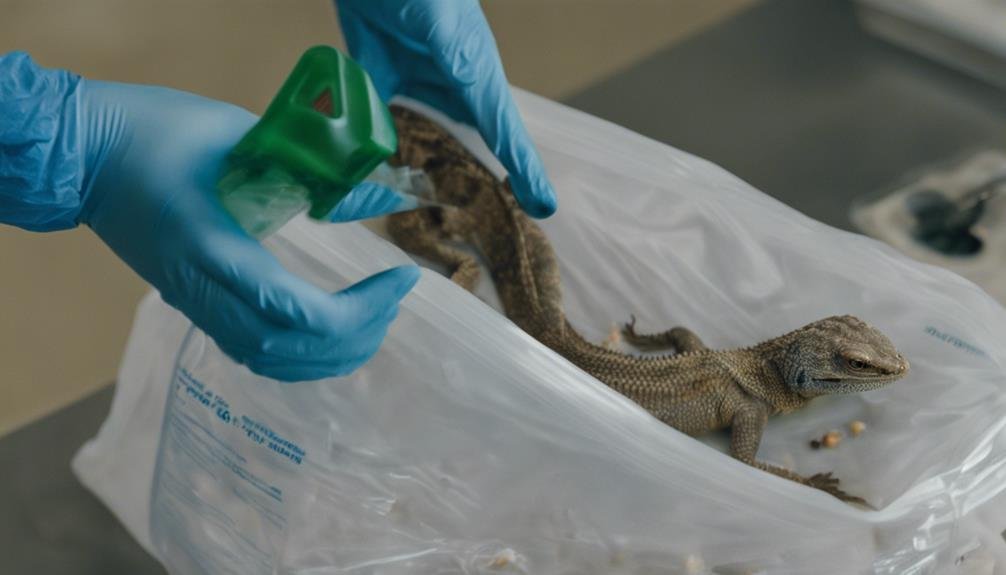

Properly disposing of dead lizards is essential to prevent pest infestations in your Home. Dead lizards can attract pests like flies and beetles due to their decaying process. These insects create a secondary pest issue and pose health risks.
For proper disposal, use gloves and a plastic bag. Carefully pick up the dead lizard, ensuring you don’t touch it directly. Place it in the bag, seal it tightly, and dispose of it in an outdoor trash bin. Immediate removal of dead lizards reduces the risk of attracting other pests and keeps your Home safer.
After disposing of the lizard, clean the area thoroughly with a disinfectant. This step helps eliminate any remainscentscent that might attract pests. Additionally, sealing potential entry points in your Home can prevent pests from being lured by the smell of decaying lizards. Check for gaps around doors, windows, and utility openings, and use caulk or weatherstripping to seal them.
Preventing Pest Infestations
Preventing pest infestations starts with understanding that deceased lizards can be a major attractant for unwanted insects. When a lizard perishes, its decomposing carcass becomes a food source for pests like flies, ants, and other scavenging insects. Addressing this issue promptly is vital to keeping your home pest-free.
Here are some steps you can take to prevent pest infestations:
- Regular Inspections: Frequently check areas where lizards are likely to hide and expire, such as basements, attics, and under furniture. Early detection helps you manage the situation before pests arrive.
- Proper Disposal: When you find a deceased lizard, dispose of it immediately and correctly. Use gloves and seal the carcass in a plastic bag before discarding it in an outdoor trash bin.
- Clean Thoroughly: After removing a deceased lizard, clean the area thoroughly with disinfectant to eliminate any lingering odors that might attract pests.
- Seal Entry Points: Inspect your Home for cracks or gaps that lizards and pests might use to enter. Seal these openings to reduce the chances of infestation.
Professional Pest Control Solutions
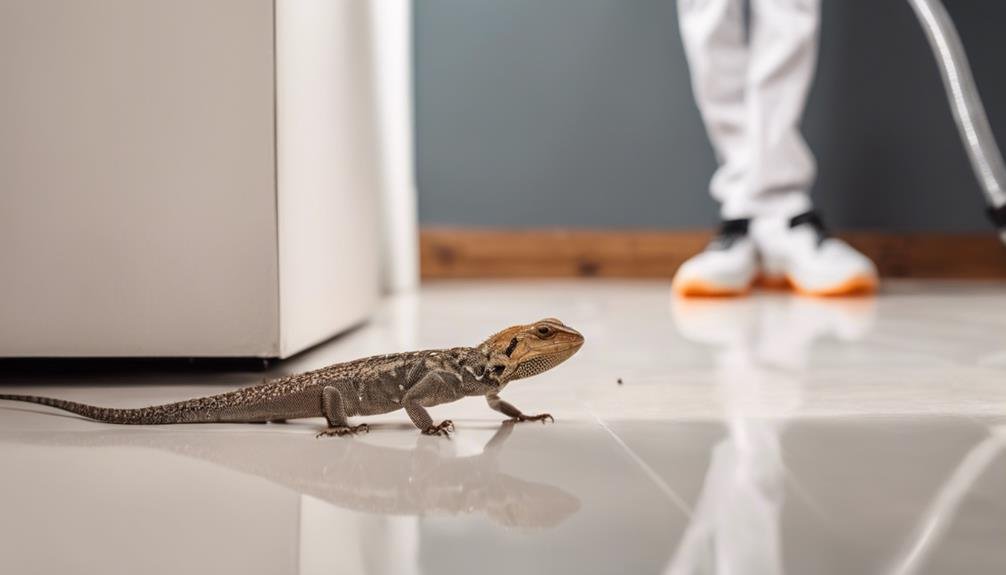

When dealing with the aftermath of a deceased lizard, professional pest control solutions can be your best ally. Dead lizards can attract pests like flies, beetles, and other scavenging insects. These pests are drawn to the odors emitted by decomposing carcasses, making prompt removal crucial to preventing an infestation.
A professional pest control service allows experts to address dead lizard issues efficiently. They remove the carcasses and implement measures to prevent secondary pest problems. By identifying and eliminating the source of the odor, these professionals help guarantee that your Home remains pest-free.
Using a pest control service means you won’t have to deal with the unpleasant task of finding and disposing of dead lizards. Additionally, professionals have the tools and knowledge to detect hidden carcasses you might miss, ensuring thorough cleanup and treatment.
Conclusion
You’ve learned that dead lizards can attract pests, posing health risks and hygiene concerns in your Home. By understanding the decomposition process and types of pests, you can take proactive steps to remove dead lizards and prevent infestations safely. Don’t hesitate to seek professional pest control solutions if needed. Keeping your home pest-free is essential for maintaining a healthy living environment, so act promptly and stay vigilant.
FAQs
1. Is It Bad to See a Dead Lizard?
Seeing a dead lizard isn’t essential. It can attract pests, causing health concerns due to secondary infestations—proper disposal is critical for odor control and to prevent pests from invading your Home or building.
2. What if a Lizard Dies in the Home?
If a lizard dies in your Home, preventing infestations is essential. Act promptly with proper disposal to remove the body. Sanitize surfaces to eliminate any residue and odor that might attract pests.
3. How Do You Get Rid of a Dead Lizard?
To properly dispose of a dead lizard, use gloves and a paper towel, then seal it in a plastic bag. Clean the area to avoid natural decomposition odors. For prevention tips, seal home entry points to keep lizards out.
4. Do Lizards Eat Other Dead Lizards?
Yes, lizards do eat other dead lizards. This scavenger behavior aids natural decomposition and can impact the ecosystem by recycling nutrients. However, it’s important to remove carcasses to prevent secondary pest infestations.

